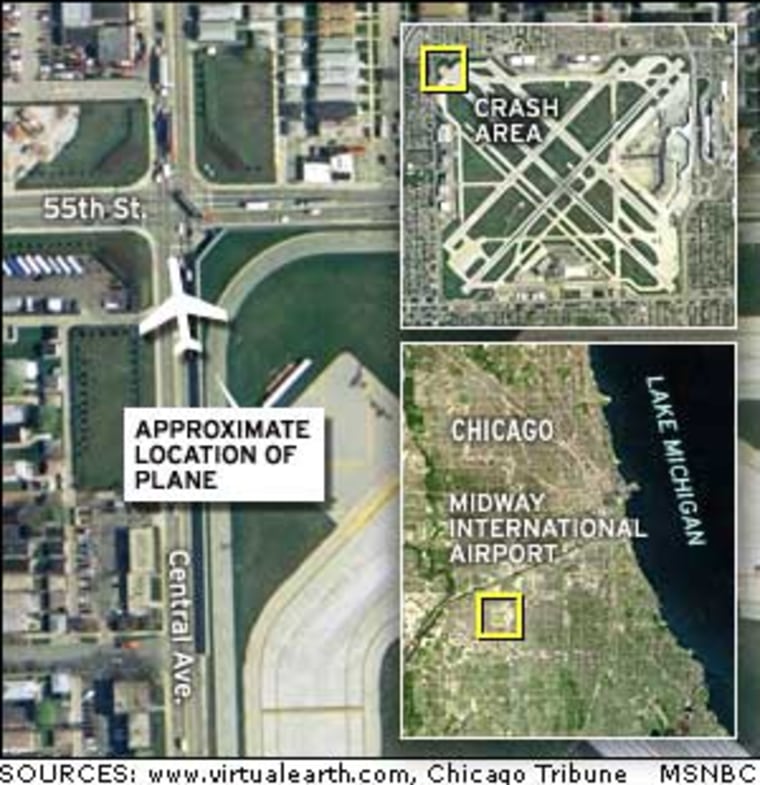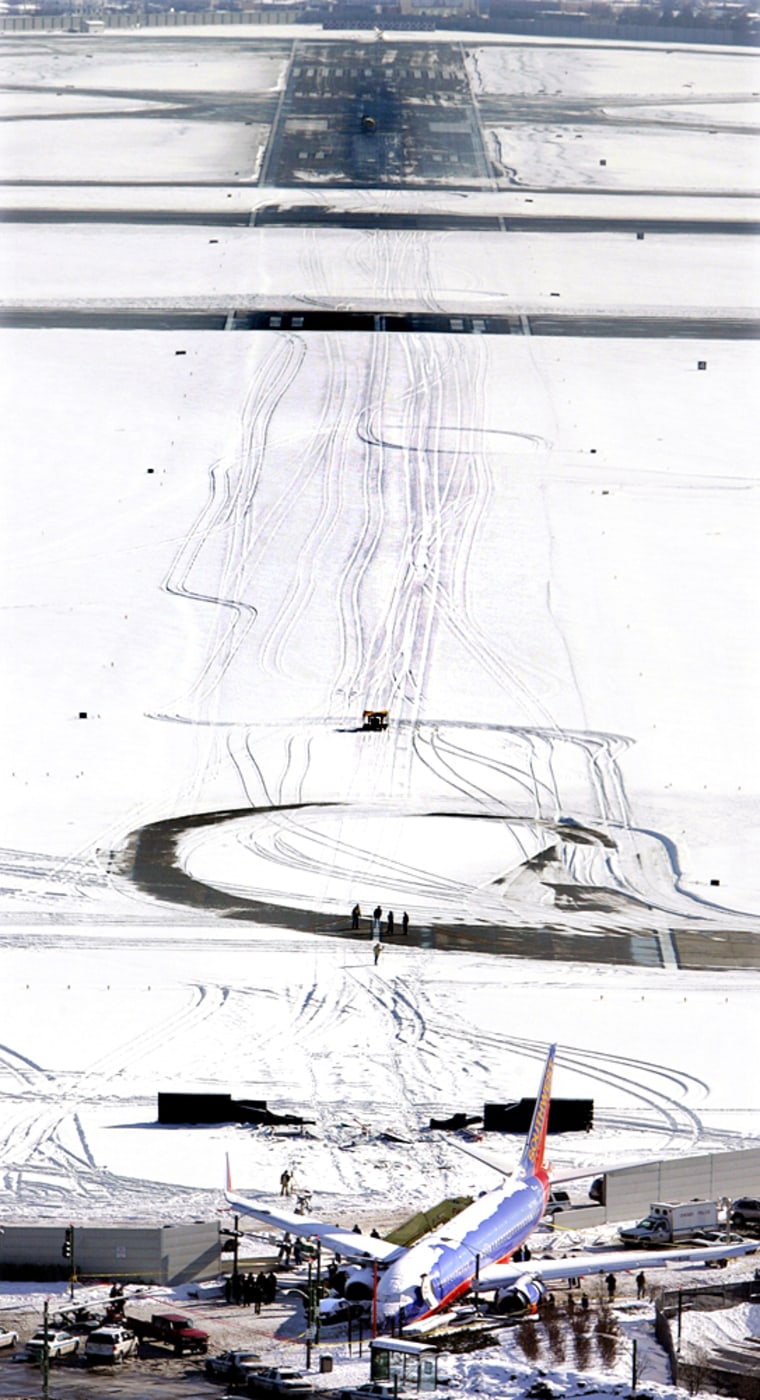The accident Thursday night that left a Southwest Airlines 737 stranded on a Chicago road after overrunning the runway revived long-lingering questions about landing larger jets at smaller airports, and what to do when those aircraft can't stop in time.
The accident comes just months after a similar crash at Toronto's Pearson airport involving an Air France A340 that skidded off a 9,000-foot runway into a ravine, and recalls similar accidents in Burbank, Calif., in 2000 and in Little Rock, Ark., in 1999.
"This is a problem that hasn't just started to occur. It's been a problem for a long time," said Grant Brophy, an air safety investigator and director of flight safety and security at Embry-Ridddle Aeronautical University in Daytona Beach, Fla.
The 2000 crash in Burbank in particular focused attention on runway overruns. As with Thursday's accident, a Southwest 737 overshot a wet runway — crashing through a fence and coming to rest just feet from a gas station. Two passengers were seriously injured. The National Transportation Safety Board determined the jet was coming in too fast and too steep.
The Little Rock crash occurred when an American Airlines MD-80 skidded down a 7,200-foot runway in heavy thunderstorms before plowing into a light tower. Eleven people, including the pilot, were killed.
Last February, a private jet at the busy Teterboro, N.J., airport aborted takeoff but shot off the end of the runway, through a fence and across a highway, struck two cars and ended up in a warehouse. Twenty people were injured.
Then in August came the Toronto accident. The International Federation of Air Line Pilots’ Associations, a coalition of commercial pilots' groups, was quick to rebuke airport officials for not having installed overrun safety measures, and noted that the issue had been "a point of contention ... for more than 25 years."
Though the NTSB routinely takes months to investigate such crashes, a major focus of the Chicago crash likely will be what details the flight crew had about the weather and runway conditions as it prepared its approach after waiting for some 30 minutes in a holding pattern over Midway.
"Given the conditions of last night, I think one of the big questions that has to be answered is how much information and what type of information did the flight crew have to make a landing at that runway?" says Greg Feith, a former NTSB investigator who investigated the Little Rock crash.
Southwest Flight 1248 landed Thursday night on Midway's runway 33 center, the airport's longest at 6,500 feet. While adequately long for jets of that size, and even for the larger 757, such relatively short runways significantly narrow pilots' margin of error — requiring even more precise control of speed and descent rate, and a more precise touchdown farther up the runway.

That last factor became an issue in the Air France crash. Witnesses noted the plane touched down well past the standard touchdown zone, perhaps as far as halfway down the runway. It was not clear Friday just where the Southwest flight touched down.
Though air-traffic controllers provide weather and runway details to pilots, that data can rapidly become dated, especially when rain and ice are involved — and several minutes can pass between an initial report and final descent.
"Conditions can change in the blink of an eye, and I don't know how quickly that information can be delivered back to a flight crew," says Brophy.
While runway hazards usually are considered in terms of takeoff or approach obstacles, potential troubles lie at the other end of the tarmac.
Railroad tracks sit about 500 feet past the end of runway 36R in Charlotte, N.C. In 1986, a Piedmont Airlines 737 was scrapped after overrunning that runway coming to rest on the railroad embankment.
The north end of both runways at Seattle-Tacoma International Airport features a large drop-off and a highway at the bottom, located close enough that runway approach lights were built on trestles over the roadway.
Runways at Boston's Logan airport and New York's LaGuardia run to the very edge of the water.
"There's a lot of airports that have very interesting things just off the end of the runway," said Bill Waldrock, also an air safety investigator and professor of safety science at Embry-Riddle.
FAA regulations require large airports to provide obstacle-free runway safety areas of 1,000 feet. But those regulations generally apply only to new runways; many older commercial airports with smaller safety areas have not been required to comply. Roads lie just 200 feet from either end of Midway's 33C.
Smaller airports
The problem is most acute at smaller airports, such as Burbank or Midway, that have been pressed into wider commercial service as U.S. air-travel capacity has surged.
Though newly built major airports like Denver International have plenty of room to expand, they only serve a handful of markets. Instead, carriers increasingly are relying on secondary airports, often holdovers from the prop era, with older infrastructure and a smaller footprint.
Until recently, such airports were mostly reserved for private planes and commuter turboprops, but they now service full-size jets. Many are in densely populated neighborhoods that make expansion costs prohibitive.
If these facilities can't expand, what to do? One popular solution endorsed by the FAA is the Engineered Material Arresting System — a mix of foam and cement that can be installed at either end of a runway. Just 600 feet of EMAS is considered equivalent to 1,000 feet of regular runway, and can successfully stop many commercial jets going 85 mph. A longer stretch of the soft material helps reduce the possibility of harm to passengers as the aircraft decelerates.
At large airports like New York's John F. Kennedy International, EMAS helped halt a 1999 overrun of an American Eagle Saab 340, and last January halted a 747 cargo jet in heavy snow. After February's crash, Teterboro airport officials similarly opted to install the system at the end of their runways.
But for smaller airports such as Midway, which is surrounded by residential neighborhoods, such systems can be difficult to install. Chicago airport officials did not respond to an inquiry Friday as to whether EMAS had been considered at Midway.
Midway's proximity to neighbors has previously had disastrous consequences: Thirty-three years ago — to the day — a United 737 crashed at Midway while executing a missed approach procedure, ultimately plowing into a nearby home and killing 43 passengers and two women in the house.
